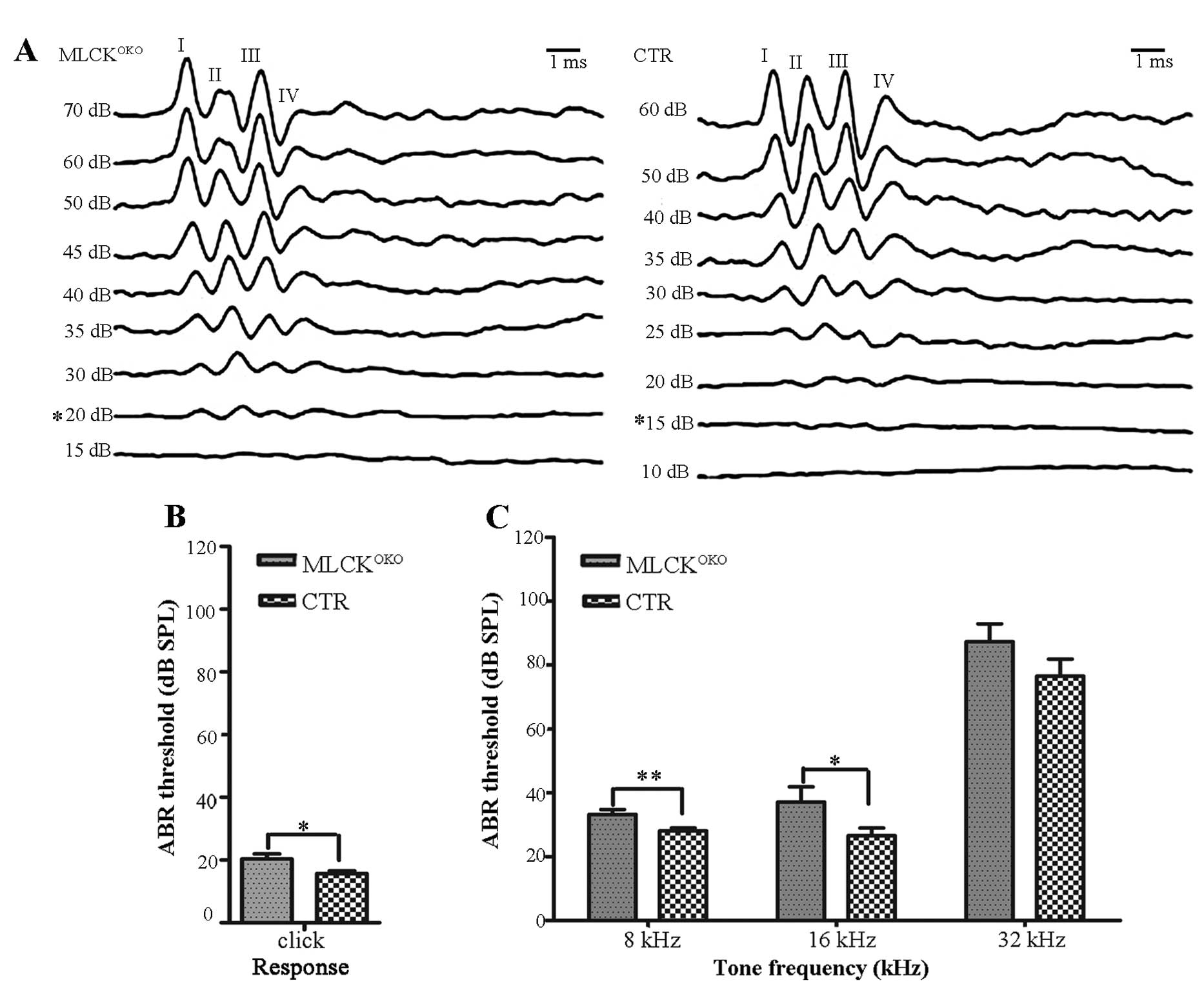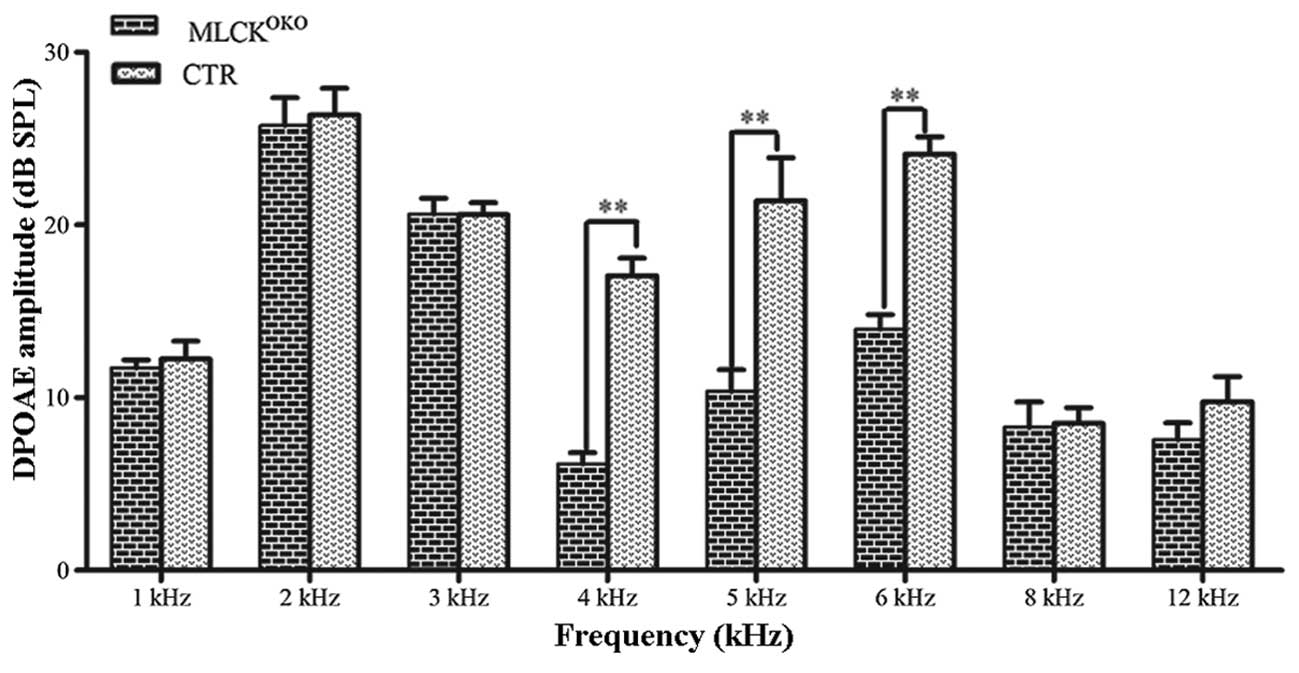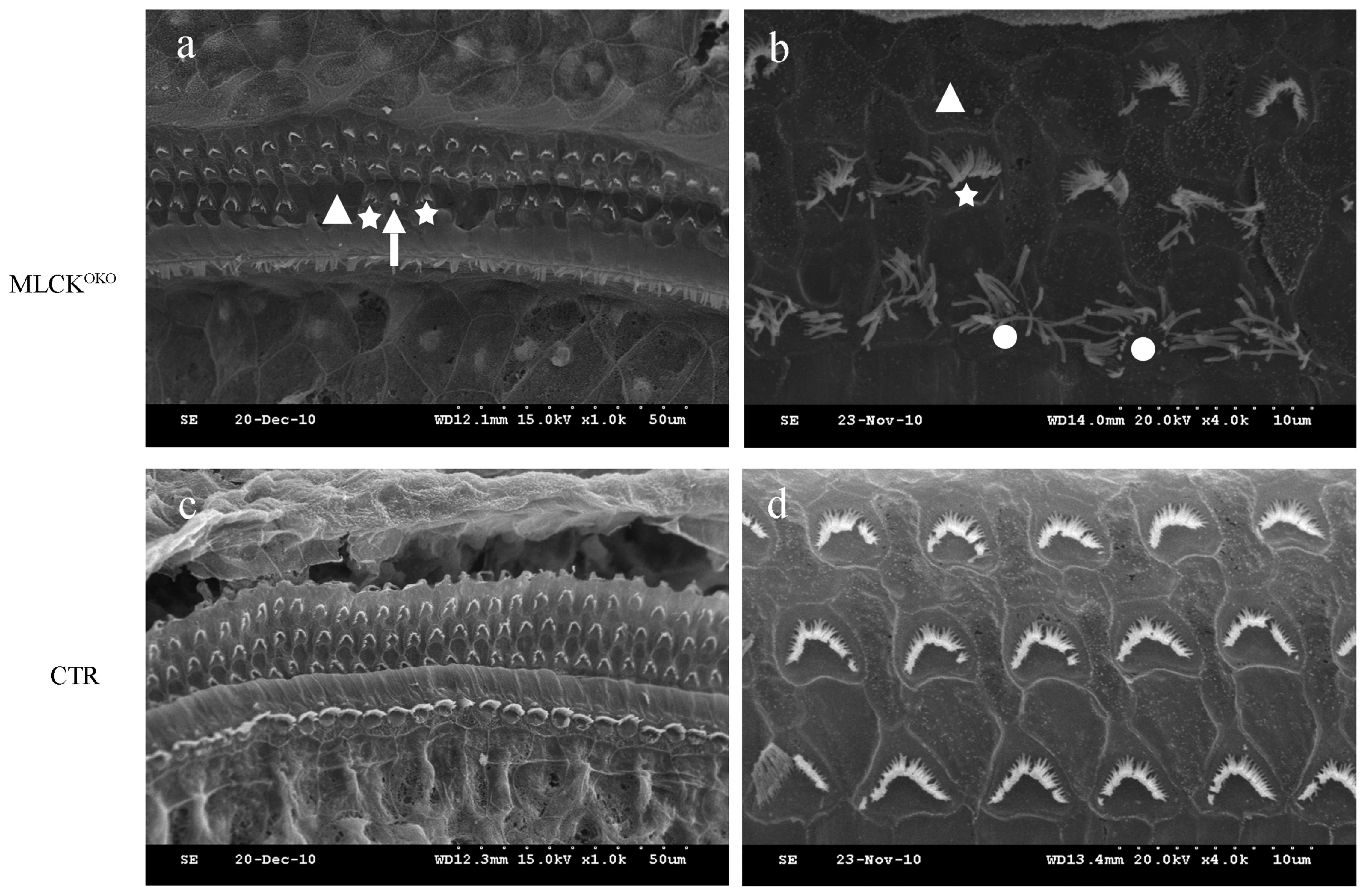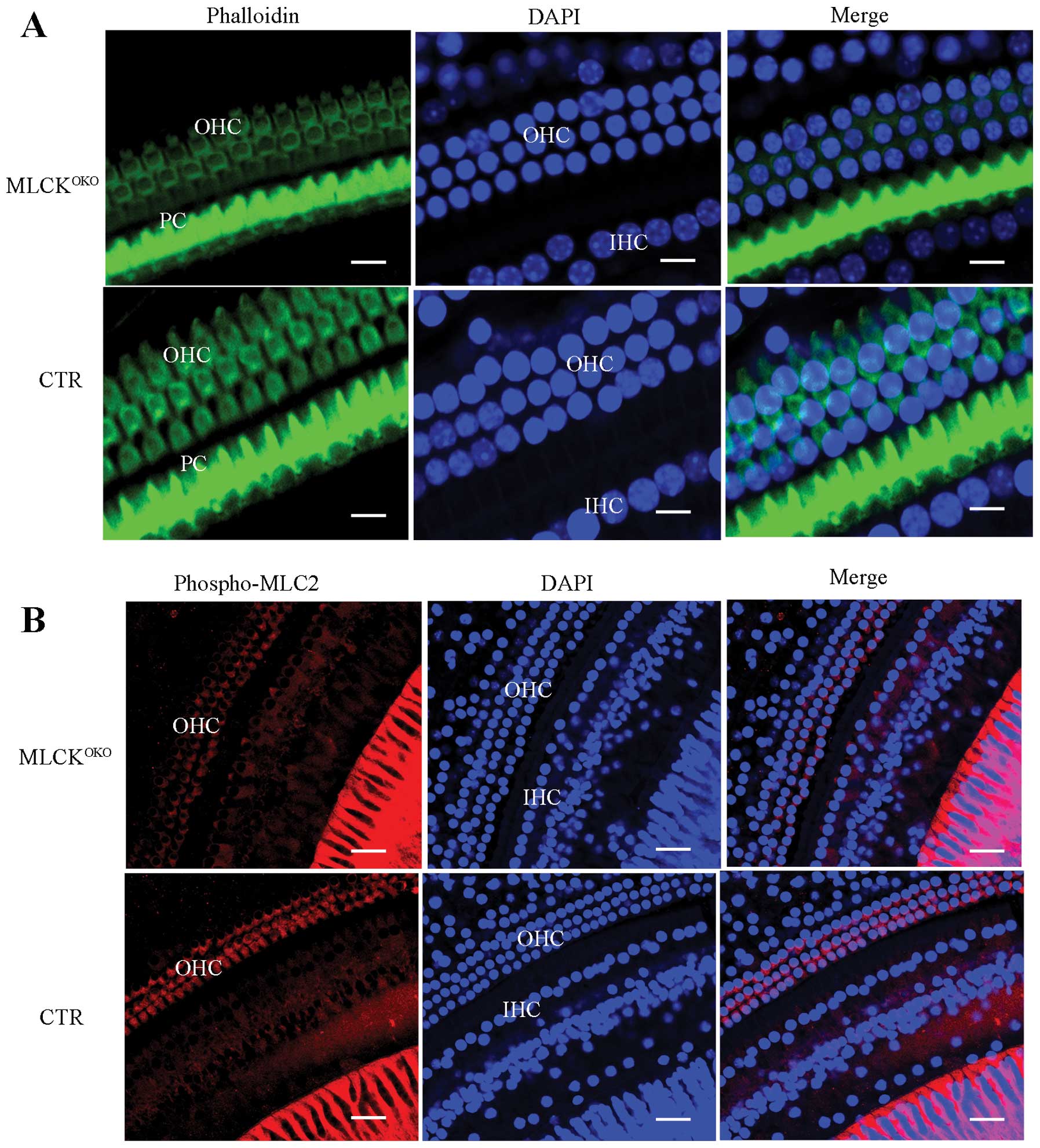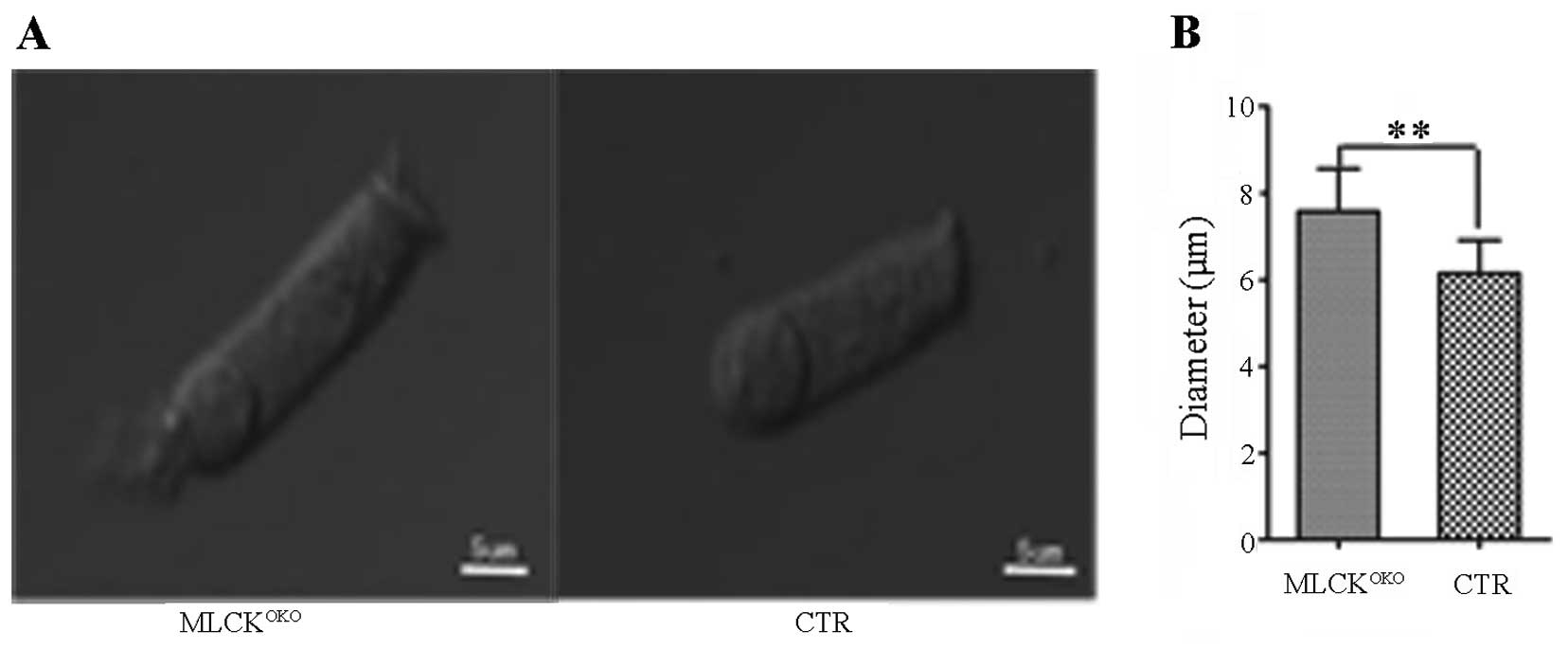Myosin light chain kinase regulates hearing in mice by influencing the F-actin cytoskeleton of outer hair cells and cochleae
- Authors:
- Published online on: January 27, 2014 https://doi.org/10.3892/ijmm.2014.1634
- Pages: 905-912
Abstract
Introduction
Hearing impairment is one of the most common disabling sensory defects in humans and varies according to age of onset and severity. Approximately 1 in 500 newborns has congenital hearing loss (1,2). Hearing impairment is a genetically heterogeneous disease; over 300 genes are thought to be necessary for hearing and over 50 deafness-causing genes have been identified (3,4). These genes encode a number of important proteins, such as myosin motors, gap junction proteins, ion channels, transcription factors, F-actin bundle proteins, F-actin crosslinking proteins and other gene expression products that have unknown functions (5–10). Studies on the localization and function of these genes have provided a great deal of insight into the mechanisms of hearing.
Hearing in mammals is characterized by high sensitivity, a wide dynamic range and sharp frequency selectivity. In the mammalian auditory pathway, the sensory receptor cells from the organ of Corti have differentiated into 1 row of inner hair cells (IHCs) on the modiolar side of the tunnel and 3 rows of outer hair cells (OHCs) on the lateral side. OHCs play a considerable role in frequency selectivity and in signal amplification through many cytoskeleton proteins, such as myosin, actin and prestin. The slow and fast motility or the electromotility of OHCs is involved in this process (11–14). The slow motile shortening of OHCs is likely performed by the phosphorylation of proteins in the actin-spectrin network of the cortical cytoskeleton in the lateral cell wall. The plasma membrane of the OHC lateral wall and stereocilia contain a number of proteins, such as myosin, actin, prestin, ankyrin, spectrin and calmodulin (15). It has been previously suggested that a number of conventional myosins play an important role in the development of the inner ear (16); however, the underlying mechanisms remain unknown. Myosin may be regulated by myosin light chain kinase (MLCK) through the phosphorylation of the regulatory light chain (RLC) in smooth muscle cells. Therefore, we hypothesized that MLCK may play an important role in hearing.
MLCK is the principal regulator of various forms of eukaryotic motility. MLCK plays an important role in many functions of non-muscle cells, including cell spreading and migration, neurite growth cone advancement, cytokinesis, cytoskeletal clustering, stress fiber formation, platelet shape changes, secretion, transepithelial permeability and cytoskeletal arrangements, which affect ion currents or ion exchange at the plasma membrane (17–20). The smooth muscle gene Mylk expresses 3 transcripts using alternative promoters, including short MLCK, long MLCK and telokin. Short MLCK is expressed in hair cells and is necessary for maintaining membrane stability in IHCs (21). Short MLCK has a catalytic core, a regulatory segment, 3 immunoglobulin-like modules, a fibronectin module, a PEVK repeat-rich region and a 3DFRXXL F-actin binding motif in the N terminus (22–24). MLCK has been shown to be expressed in IHCs (21). In a recent study, mice carrying a specific deletion of MLCK in the IHCs (MLCKIKO mice) presented with impaired hearing, whose mutant IHCs produced ball-like structures around their hair bundles in vivo, displayed less resistance to hypoosmotic solution, manifested less membrane F-actin and reduced the phosphorylation of myosin light chain in vitro. The authors demonstrated that MLCK is necessary for maintaining the membrane stability of IHCs (21). The exact role of MLCK in OHCs remains unclear. In the present study, using an animal model of mice with a specific deletion of MLCK in OHCs, we investigated the function and regulatory mechanisms of MLCK in OHCs, and found that MLCK has important functions in OHCs.
Materials and methods
Generation of MLCK OHC-specific knockout mice
The Institutional Animal Care and Use Committee (IACUC) of the Model Animal Research Center of Nanjing University approved all animal procedures. All experiments were conducted in accordance with the IACUC guidelines (Nanjing, China) (permit no. AP#MZ3).
Floxed Mylk mice (Mylkflox/flox) with a congenic background (B6:129) which were crossed with OHC-Cre transgenic mice (25), were kindly provided by the Department of Development Neurobiology, St. Jude Children’s Research Hospital (Chicago, IL, USA). The OHC-Cre transgenic mice were generated with a BAC containing the prestin gene to specifically enforce Cre expression in OHCs. The resultant mice (Mylkflox/flox: OHC-Cre; designated as MLCKOKO) were OHC-specific knockout mice for MLCK. The littermates of MLCKOKO (Mylkflox/+: OHC-Cre) were used as controls (CTR). These mice were maintained on a 12-h light/dark cycle under specific pathogen-free (SPF) conditions in standard animal rooms of the National Resource Center for Mutant Mice (NRCMM) of China.
Hearing tests
Acoustic brainstem responses (ABRs) reflect the response of the auditory system to acoustic stimuli. Distortion product otoacoustic emissions (DPOAEs) measure acoustic energy, which is generated in the form of otoacoustic emissions (OAEs), that are produced by OHCs in the cochlea. We measured ABRs and DPOAEs to perform a robust assessment of hearing impairment in mice.
MLCKOKO and CTR mice, ranging in age from 2 to 9 months, were used in the experiments. All tests were performed in a single-walled, soundproof booth and were repeated 3 times for each mouse. The mice were anesthetized by an intraperitoneal injection of avertin at an initial dose of 500 mg/kg body weight and maintained with a half-dose every 20 min. After testing was completed, all mice were kept warm on a heating pad, at 37°C, until they fully recovered from the anesthesia.
ABR recordings
ABR waveforms were recorded with subcutaneous needle electrodes at the vertex (active), posterior bulla region of the right ear (reference) and tip of the nose (ground). An outlay trumpet was placed 10 cm in front of the nasal tip. Click and tone pips of 8, 16 and 32 kHz were generated using the evoked generation workstation system 3 (Tucker Davis Technologies Inc.; Gainesville, FL, USA) with computerized SigGen32 software. The response was averaged (n=1,024) and displayed from 110 to 0 dB with decreasing steps of 5 dB. The threshold of hearing was determined by observing the lowest intensity of sound required to elicit a characteristic waveform.
DPOAE recordings
DPOAEs were recorded and analyzed with workstation system 3 (Tucker Davis Technologies Inc.) using computerized SigGen32 software. The acoustic probe was lengthened with a tapered plastic tube to ensure a tight fit in the external ear canal and the formation of a closed acoustic system. The f2/f1 frequency ratio was maintained at 1.20, and the value of f2 varied from 1 to 12 kHz (8 points). The sound intensities at each frequency (f1 and f2) were 65 dB. The signal-to-noise ratios (SNRs) of the DPOAE (2f1-f2) data at the various f2 values were obtained.
Histopathological analysis
Mice were euthanized with an overdose of avertin and were then perfused with phosphate-buffered solution (PBS) followed by 4% paraformaldehyde (Sigma-Aldrich, St. Louis, MO, USA). The acoustic capsule was removed. The cochleae were removed through an open window over the apical turn of the cochlea and stored overnight in 4% paraformaldehyde in PBS at 4°C. For decalcification, the cochleae were incubated in 10% ethylenediaminetetraacetic acid (EDTA) (pH 7.4) for 5 days at 4°C prior to standard histological examination. Briefly, the specimens were dehydrated in a graded series of ethanol solutions before being embedded in paraffin and the serial sections (7 μm) of the cochleae were stained with hematoxylin and eosin (H&E).
Scanning electron microscopy (SEM) assay
Mice were euthanized with an overdose of avertin and perfused with PBS followed by glutaraldehyde fixative (2.5% glutaraldehyde in PBS). Cochleae were selected and post-fixed again in glutaraldehyde fixative at 4°C for 4–6 h followed by decalcification. For SEM, the bone and stria vascularis surrounding the cochleae were dissected, and the tectorial membrane was removed to expose the organ of Corti. The organ of Corti was fixed in 1% osmium tetroxide, dehydrated and critical point-dried. The organ of Corti was sputter-coated with gold and the images were collected using an S-3000 N scanning electron microscope (Hitachi, Tokyo, Japan) at 15 kV.
Immunofluorescence assay for inner ear sensory epithelia
The cochleae were removed through the round window, infused with 4% paraformaldehyde in PBS and post-fixed at 4°C for 3 h. Following decalcification in 10% EDTA overnight at room temperature, the Corti sensory epithelium was dissected from the soft cochlea. The sensory epithelia were permeabilized with 0.5% Triton X-100 in PBS for 20 min and washed 3 times with PBS. Non-specific binding was blocked in PBS buffer containing 5% goat serum, 1% bovine serum albumin (BSA) and 0.1% Triton X-100 for 1 h at room temperature. The tissues were incubated with primary antibody overnight at 4°C and washed 3 times with 0.1% Tween in PBS followed by incubation with the secondary antibody for 1.5 h at room temperature. In the experiments, anti-phospho myosin light chain 2 (Ser 19) antibody (1:150 dilution; Cell Signaling; Cell Signaling Technology, BSN, USA) was used as the primary antibody, and Alexa Fluor 488-conjugated goat anti-rabbit IgG and Alexa Fluor 555-conjugated goat anti-mouse or anti-rabbit IgG were used as the secondary antibodies (Molecular Probes; Carlsbad, CA, USA). F-actin was labeled by Alexa Fluor 488-conjugated Phalloidin (Invitrogen; Carlsbad, CA, USA), while DAPI (Sigma; Carlsbad, CA, USA) was used to stain the nucleus. Immunofluorescent signals were examined under an Olympus confocal microscope (Olympus, Tokyo, Japan).
Isolation of OHCs and measurement of the OHC diameter
Three-month-old mice of either gender were anesthetized by an intraperitoneal injection of avertin. The bullae were excised, and the lateral wall of the cochleae and stria vascularis were removed with a fine needle under a dissection microscope. The organ of Corti was dissected, and OHCs were enzymatically isolated at room temperature with collagenase (type IV Sigma-Aldrich, 1 mg/ml). The isolated OHCs were transferred with a glass pipette to a chamber filled with D-Hank’s solution, and their diameter was measured using an Olympus confocal microscope. The D-Hank’s solution contained 136.9 mM/l NaCl, 5.4 mM/l KCl, 0.3 mM/l Na2HPO4, 4.2 mM/l NaHCO3 and 0.4 mM/l KH2PO4 (300 mOsm/l, pH 7.2). ImageJ software was used to analyze the diameter of the OHCs.
Statistical analysis
The data are expressed as the means ± SEM. Differences concerning the hearing and the diameter of the OHCs between the 2 groups were compared with one-way analysis of variance followed by a Student-Newman-Keul’s t-test with a value of P<0.05 considered to indicate a statistically significant difference. We used the χ2 test to analyze the data of the missing and disordered OHC stereocilia in the apex turn with P<0.01 as the level of significance. SPSS 17.0 (SPSS Inc., Chicago, IL, USA) software was used for statistical analysis.
Results
MLCKOKO mice display an increased ABR threshold and decreased DPOAE amplitudes
We recorded and characterized the ABRs of MLCKOKO mice that were between 2 and 9 months of age and compared them with those of the control mice. An example of ABR waves is presented in Fig. 1A. The recordings were 10-msec-long and included a 2-msec pre-stimulus period. There were typically 4–5 waves in each 10-msec trace, as reported previously by Song et al (26). Table I shows the ABR thresholds of the mice of different ages and at different frequencies.
Table IThe mean acoustic brainstem response (ABR) thresholds and their variance estimates (standard deviations) for each test, age group of mice and auditory stimulus, and the numbers of mice tested in each group. |
The ABR thresholds did not differ significantly between the MLCKOKO mice and CTR mice at 2–5 and 8–9 months of age (P>0.05 for all frequencies). Compared with the CTR mice, the MLCKOKO mice (6–7 months old) displayed a significantly higher threshold in response to clicks (20.35±8.49 dB vs. 15.68±4.76 dB of CTR, P<0.05) and tones (8 kHz: 33.21±8.18 dB vs. 28.10±4.89 dB of CTR, P<0.01; 16 kHz: 37.14±25.14 dB vs. 26.55±13.03 of CTR, P<0.05). The mean ABR thresholds between the 2 experimental groups (CTR and MLCKOKO mice) are graphically illustrated in Fig. 1B and C for the 6- to 7-month-old age groups.
ABR was used to assess the function of the entire auditory pathway objectively, whereas DPOAE evaluated cochlear function. We measured the DPOAE thresholds of the MLCKOKO mice and CTR mice at the age of 3 months. In DPOAE testing, the distortion product 2f1-f2 was significantly decreased in the MLCKOKO mice compared with the control mice. Fig. 2 illustrates the comparison of the mean and standard error of DPOAE thresholds between the CTR and MLCKOKO mice. Significant differences were observed between the 2 groups of mice (t-test, P<0.01 at 4, 5 and 6 kHz frequencies). The threshold shifts occurred at 4, 5 and 6 kHz frequencies, and in the MLCKOKO mice, the average amplitudes of the DPOAEs decreased by >10 dB.
Histological analysis of the cochlea structure
Light microscopy analysis of the cochleae sections displayed the normal architecture of the organ of Corti with IHCs, OHCs, Hensen’s cells, stria vascularis and spiral ganglion cells in 3-month-old MLCKOKO mice, although these mice displayed impaired hearing function (data not shown).
By contrast, SEM assays of the MLCKOKO mice at 3, 5, 6, 7 and 9 months of age revealed the degeneration of the OHC stereocilia. On the surface preparation of each cochlea, the missing hair cell stereocilia were observed primarily in the OHCs towards the apex turn of the cochlea, which indicated that MLCK may have some influence on the aggregation of the stereocilia. However, we found fewer OHCs missing stereocilia in the cochlear basilar membrane of the CTR mice. The disarrangement of the OHC stereociliary bundles was another morphological finding. There was no observable loss of IHC stereocilia through the entire basilar membrane of the cochlea (Fig. 3).
We separately counted the number of missing and disordered OHC stereocilia in the apex turn, and we conducted a χ2 test to analyze these data using SPSS 17.0 software with P<0.05 considered to indicate a statistically significant difference. The results are presented in Table II.
Table IIComparative analysis of the missing and disordered outer hair cell (OHC) stereocilia in the apex turn between the CTR and MLCK OHC-specific knockout (MLCKOKO) mice. |
MLCK-deficient OHCs present reduced F-actin and RLC phosphorylation
In order to determine whether the density of F-actin was altered, we stained the inner ear cells with phalloidin. Most of the phalloidin signal was distributed around the OHC cell membrane and the button area. The CTR IHCs had strong and continuous F-actin staining in addition to membrane structure. However, F-actin staining in the MLCK-deficient OHCs was weak and discontinuous (Fig. 4A).
MLCK is a dedicated kinase for myosin light chain phosphorylation. RLC phosphorylation is also involved in various cellular processes, in addition to its important role in smooth muscle contraction. It has been demonstrated that RLC phosphorylation enhances the formation of polymerized F-actin (27). Thus, we measured RLC phosphorylation in OHCs by staining the phosphorylated RLCs with a specific antibody. In the MLCKOKO cochleae, many OHCs showed obvious weak staining of the phosphorylated RLCs in contrast to the cochleae of the CTRs (Fig. 4B).
Diameter of MLCK-deficient OHCs is increased
Changes in the volume of hair cells are important for hearing sensitivity, and cell volume is primarily regulated by membrane tethering and cytoskeleton organization (28,29). A comparison of the OHC diameters between 3-month-old MLCKOKO and control mice revealed that the diameters differed (Fig. 5). Compared with the CTR mice, the OHCs of the MLCKOKO mice were longer and narrower (7.48±1.29 μm vs. 6.12±0.88 μm in diameter of CTR, P<0.01).
Discussion
Genetic and environmental factors are the two main causes of hearing loss. Genetic factors constitute 60% or more of the main reason of hearing loss (30). Clearly identifying causative genes is the key to the study of hereditary hearing loss. The completion of the Human Genome Project has provided us with an important platform for hereditary hearing loss research. Notably, mice provide a good model system for studying human hearing loss due to the anatomical, functional, physiological and pathological similarities between humans and mice. When a candidate gene related to hearing loss in humans is proposed, we can verify the hypothesis by engineering similar mutations in mice.
It has been documented that there are hereditary deafness-related genes, including cytoskeletal proteins, extracellular matrix proteins, channel and gap junction proteins, transcription factors, mitochondrial genes and numerous other structures and signaling molecules. However, the mechanisms of action of these genes and their role in hearing remains unclear.
The cytoskeleton is a fibrous protein filament that maintains cell shape, cell movement, information transmission, energy conversion and other functions. The auditory system is complex, and the hair cells in the inner ear play a significant role in hearing. The protein components of the cytoskeleton of hair cells, such as actin, actin-binding protein, myosin, cadherin and Rho GTPases, are closely related to the mechano-chemical and -electrical transduction processes in hearing. Mutations of these proteins may lead to abnormalities in the structure and function of the hair cell bodies and stereocilia. Actin and myosin are the basic components of the hair cell structure (31–35). There are a variety of regulatory pathways involved in the interaction of actin and myosin in the smooth muscle. The phosphorylation of the Ca2+-dependent RLC is important in regulating MLCK enzyme activity (36–38). MLCK may play an important role in active OHC regulation, as the cell body and stereocilia of the OHCs have a large amount of actin and myosin. We specifically deleted the Mylk gene in OHCs by crossing floxed Mylk mice with transgenic mice that expressed Cre in their OHCs. This type of mouse model is useful for clarifying the function of MLCK in OHCs.
OHCs can regulate cochlear sensitivity to sound stimulation and adjust the gain of the cochlear amplifier to moderate sound intensities. This process involves the stereociliary and somatic motility of OHCs. Thus, we specifically knocked out the Mylk gene in OHCs to elucidate its role in the hearing process.
We evaluated hearing impairment by testing ABRs and DPOAEs in mice. Compared with the controls, 6- to 7-month-old MLCK-deficient mice showed impaired hearing with a 5- to 10-dB SPL increase in ABR thresholds in response to clicks and tones, and 3-month-old MLCK-deficient mice had significantly reduced DPOAE amplitudes at low frequencies. The SEM results revealed that the stereocilia of the OHCs were missing, and stereocilia bundles were scattered on the apex turn. It has been documented that low-frequency hearing corresponds to OHCs in the apex turn. These results demonstrate that the deletion of MLCK has some influence on the active regulation of OHCs.
Our results aslo demonstrated that F-actin and RLC phosphorylation staining in MLCK-deficient OHCs was weak, and that their diameter was increased. MLCK may strengthen the cell membrane through non-kinase activity. MLCK can bundle F-actin and other motor proteins through the non-catalytic N-terminal extension to enhance the cytoskeletal structure and cell membrane. However, there was no significant difference in histology. Perhaps the role of MLCK in the regulation of OHC somatic motility is small, and is more dependent on prestin.
Transducer channels located at the tips of the stereocilia are mechanically gated by mechanoelectrical transduction. The channels open when the cilia are bent toward the tallest one, and close when they bend towards the opposite direction (39). Stereocilia are rich in actin and myosin, and stereociliary motility is associated with Ca2+. The receptor potential of stereocilia is formed by K+ influx and cell depolarization. It opens L-type voltage-dependent calcium channels and allows Ca2+ influx, causing a series of reactions (40). This model predicts that MLCK deletion can alter the architecture of the stereocilia and thus affect the transduction channels at the tips of the stereocilia.
Acknowledgements
We thank Professor Minsheng Zhu, Dr Weiqi He, Dr Yajing Peng, Dr Chen Chen, Dr Chenghai Zhang, Dr Yanning Qiao, Dr Caiping Chen and Dr Tao Tao of the Model Animal Research Center of Nanjing University in China. This study was supported by grants from the National Natural Science Funding of China (nos. 30973302 and 81371090), and the Medical Youth Priming Project of Nanjing (QYK1162).
References
|
Thomas PC: Of specialty interest: publications of the National Institute on Deafness and Other Communication Disorders. ORL Head Neck Nurs. 20:26–30. 2002.PubMed/NCBI | |
|
Battey JF Jr: News from the National Institute on Deafness and Other Communication Disorders. Am J Otol. 19:263–265. 1998.PubMed/NCBI | |
|
Steel KP and Kros CJ: A genetic approach to understanding auditory function. Nat Genet. 27:143–149. 2001. View Article : Google Scholar : PubMed/NCBI | |
|
Arnos KS: The implications of genetic testing for deafness. Ear Hear. 24:324–331. 2003. View Article : Google Scholar : PubMed/NCBI | |
|
Krendel M and Mooseker MS: Myosins: tails (and heads) of functional diversity. Physiology. 20:239–251. 2005. View Article : Google Scholar : PubMed/NCBI | |
|
Etournay R, Zwaenepoel I, Perfettini I, Legrain P, Petit C and El-Amraoui A: Shroom2, a myosin-VIIa- and actin-binding protein, directly interacts with ZO-1 at tight junctions. J Cell Sci. 120:2838–2850. 2007. View Article : Google Scholar : PubMed/NCBI | |
|
Friedman TB, Sellers JR and Avraham KB: Unconventional myosins and the genetics of hearing loss. Am J Med Genet. 89:147–157. 1999. View Article : Google Scholar : PubMed/NCBI | |
|
Mermall V, Post PL and Mooseker MS: Unconventional myosins in cell movement, membrane traffic, and signal transduction. Science. 279:527–533. 1998. View Article : Google Scholar : PubMed/NCBI | |
|
Libby RT and Steel KP: The roles of unconventional myosins in hearing and deafness. Essays Biochem. 35:159–174. 2000.PubMed/NCBI | |
|
Redowicz MJ: Myosins and deafness. J Muscle Res Cell Motil. 20:241–248. 1999. View Article : Google Scholar | |
|
Ashmore JF: A fast motile response in guinea-pig outer hair cells: the cellular basis of the cochlear amplifier. J Physiol. 388:323–347. 1987. View Article : Google Scholar : PubMed/NCBI | |
|
Dallos P and Fakler B: Prestin, a new type of motor protein. Nat Rev Mol Cell Biol. 3:104–111. 2002. View Article : Google Scholar : PubMed/NCBI | |
|
Dulon D and Schacht J: Motility of cochlear outer hair cells. Am J Otol. 13:108–112. 1992.PubMed/NCBI | |
|
Santos-Sacchi J: New tunes from Corti’s organ: the outer hair cell boogie rules. Curr Opin Neurobiol. 13:459–468. 2003. | |
|
Knipper M, Zimmermann U, Köpschall I, Rohbock K, Jüngling S and Zenner HP: Immunological identification of candidate proteins involved in regulating active shape changes of outer hair cells. Hear Res. 86:100–110. 1995. View Article : Google Scholar : PubMed/NCBI | |
|
Yamamoto N, Okano T, Ma XF, Adelstein RS and Kelley MW: Myosin II regulates extension, growth and patterning in the mammalian cochlear duct. Development. 136:1977–1986. 2009. View Article : Google Scholar : PubMed/NCBI | |
|
Schoenwaelder SM and Burridge K: Bidirectional signaling between the cytoskeleton and integrins. Curr Opin Cell Biol. 11:274–286. 1999. View Article : Google Scholar : PubMed/NCBI | |
|
Bresnick AR: Molecular mechanisms of nonmuscle myosin-II regulation. Curr Opin Cell Biol. 11:26–33. 1999. View Article : Google Scholar : PubMed/NCBI | |
|
Szaszi K, Kurashima K, Kapus A, Paulsen A, Kaibuchi K, Grinstein S and Orlowski J: RhoA and rho kinase regulate the epithelial Na+/H+ exchanger NHE3. Role of myosin light chain phosphorylation. J Biol Chem. 275:28599–28606. 2000. View Article : Google Scholar : PubMed/NCBI | |
|
Aromolaran AS, Albert AP and Large WA: Evidence for myosin light chain kinase mediating noradrenaline-evoked cation current in rabbit portal vein myocytes. J Physiol. 524:853–863. 2000. View Article : Google Scholar : PubMed/NCBI | |
|
Zhu GJ, Wang F, Chen C, Xu L, Zhang WC, Fan C, Peng YJ, Chen J, He WQ, Guo SY, Zuo J, Gao X and Zhu MS: Myosin light-chain kinase is necessary for membrane homeostasis in cochlear inner hair cells. Plos One. 7:e348942012. View Article : Google Scholar : PubMed/NCBI | |
|
Birukov KG, Schavocky JP, Shirinsky VP, Chibalina MV, Van Eldik LJ and Watterson DM: Organization of the genetic locus for chicken myosin light chain kinase is complex: multiple proteins are encoded and exhibit differential expression and localization. J Cell Biochem. 70:402–413. 1998. View Article : Google Scholar | |
|
Smith AF, Bigsby RM, Word RA and Herring BP: A 310-bp minimal promoter mediates smooth muscle cell-specific expression of telokin. Am J Physiol. 274:C1187–C1195. 1998.PubMed/NCBI | |
|
Watterson DM, Schavocky JP, Guo L, Weiss C, Chlenski A, Shirinsky VP, Van Eldik LJ and Haiech J: Analysis of the kinase-related protein gene found at human chromosome 3q21 in a multi-gene cluster: organization, expression, alternative splicing, and polymorphic marker. J Cell Biochem. 75:481–491. 1999. View Article : Google Scholar | |
|
Li MY, Tian Y, Fritzsch B, Gao JG, Wu XD and Zuo J: Inner hair cell Cre-expressing transgenic mouse. Genesis. 39:173–177. 2004. View Article : Google Scholar : PubMed/NCBI | |
|
Song L, McGee JA and Walsh EJ: Consequences of combined maternal, fetal and persistent postnatal hypothyroidism on the development of auditory function in Tshrhyt mutant mice. Brain Res. 1101:59–72. 2006. View Article : Google Scholar : PubMed/NCBI | |
|
Goeckeler ZM: Myosin light chain kinase-regulated endothelial cell contraction: the relationship between isometric tension, actin polymerization, and myosin phosphorylation. J Cell Biol. 130:613–627. 1995. View Article : Google Scholar | |
|
Li J and Verkman AS: Impaired hearing in mice lacking aquaporin-4 water channels. J Biol Chem. 276:31233–31237. 2001. View Article : Google Scholar : PubMed/NCBI | |
|
Frolenkov GI, Belyantseva IA, Friedman TB and Griffith AJ: Genetic insights into the morphogenesis of inner ear hair cells. Nat Rev Genet. 5:489–498. 2004. View Article : Google Scholar : PubMed/NCBI | |
|
Marazita ML, Ploughman LM, Rawlings B, Remington E, Arnos KS and Nance WE: Genetic epidemiological studies of early-onset deafness in the U.S. school-age population. Am J Med Genet. 46:486–491. 1993. View Article : Google Scholar : PubMed/NCBI | |
|
Lynch ED, Lee MK, Morrow JE, Welcsh PL, Leon PE and King MC: Nonsyndromic deafness DFNA1 associated with mutation of a human homolog of the Drosophila gene diaphanous. Science. 278:1315–1318. 1997. View Article : Google Scholar : PubMed/NCBI | |
|
Liu XZ, Walsh J, Mburu P, Kendrick-Jones J, Cope MJ, Steel KP and Brown SD: Mutations in the myosin VIIA gene cause non-syndromic recessive deafness. Nat Genet. 16:188–190. 1997. View Article : Google Scholar : PubMed/NCBI | |
|
Wilson SM, Householder DB, Coppola V, Tessarollo L, Fritzsch B, Lee EC, Goss D, Carlson GA, Copeland NG and Jenkins NA: Mutations in Cdh23 cause nonsyndromic hearing loss in waltzer mice. Genomics. 74:228–233. 2001. View Article : Google Scholar : PubMed/NCBI | |
|
Lalwani AK, Goldstein JA, Kelley MJ, Luxford W, Castelein CM and Mhatre AN: Human nonsyndromic hereditary deafness DFNA17 is due to a mutation in nonmuscle myosin MYH9. Am J Hum Genet. 67:1121–1128. 2000. View Article : Google Scholar : PubMed/NCBI | |
|
Grimsley-Myers CM, Sipe CW, Geleoc GS and Lu X: The small GTPase Rac1 regulates auditory hair cell morphogenesis. J Neurosci. 29:15859–15869. 2009. View Article : Google Scholar : PubMed/NCBI | |
|
Walker JW, Gilbert SH, Drummond RM, Yamada M, Sreekumar R, Carraway RE, Ikebe M and Fay FS: Signaling pathways underlying eosinophil cell motility revealed by using caged peptides. Proc Natl Acad Sci USA. 95:1568–1573. 1998. View Article : Google Scholar : PubMed/NCBI | |
|
Ding HL, Ryder JW, Stull JT and Kamm KE: Signaling processes for initiating smooth muscle contraction upon neural stimulation. J Biol Chem. 284:15541–15548. 2009. View Article : Google Scholar : PubMed/NCBI | |
|
Breckenridge MT, Dulyaninova NG and Egelhoff TT: Multiple regulatory steps control mammalian nonmuscle myosin II assembly in live cells. Mol Biol Cell. 20:338–347. 2009. View Article : Google Scholar : PubMed/NCBI | |
|
Cheatham MA, Huynh KH, Gao J, Zuo J and Dallos P: Cochlear function in Prestin knockout mice. J Physiol. 560:821–830. 2004. View Article : Google Scholar : PubMed/NCBI | |
|
Mills DM and Schmiedt RA: Metabolic presbycusis: differential changes in auditory brainstem and otoacoustic emission responses with chronic furosemide application in the gerbil. J Assoc Res Otolaryngol. 5:1–10. 2004. View Article : Google Scholar |



